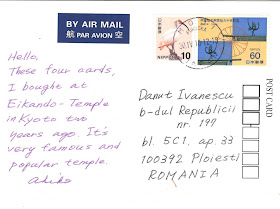 |
| 3333 |
Founded in Kyoto by the monk Shinshō (797-873), a pupil of Kūkai, as part part of the Shingon sect, Eikan-dō (View of Eternity Hall) is the head temple for the Seizan branch of Japan's Jōdo-shū Buddhist sect. Formally known as Zenrin-ji (Temple in a Calm Grove), it is famous for its fall foliage and for its prominence in the past as a center of learning. Its buildings, most of them connected by covered walkways and staircases, are scattered among a range of heights. It also has two other names: Shōju-raigō-san (Mountain where the saints welcome you), while Muryōsu-in (Temple of Immeasurable Fortune).
 |
| 3339 |
In the 11th century, it had a popular head priest named Eikan, who is credited with acquiring the temple's main object of worship, an unusual statue of the Amida Buddha with his head turned sidewards. According to legend, Eikan was walking through the temple one day, when the statue, which was originally facing forward, turned its head towards the priest and talked to him. In the 13th century, a later head priest converted the temple to the Jodo sect.
 |
| 3372 |
Eikando's main buildings are built alongside the base of the hillside and are connected by wooden corridors. The first building that visitors enter is the Shakado (Hall of the historical Buddha) with a small rock garden and beautifully painted sliding doors (fusuma). Walking through the corridors, visitors also pass by the Miedo which enshrines the Jodo sect's founder Honen and the Amidado (Amida Hall) which houses the Amida statue.
 |
| 3398 |
The temple most recognizable building is its Tahōtō Pagoda, which is nestled in the trees on the hillside above the temple's other buildings. Its style pagoda are two story structures, whose first stories are square and second stories are round. Visitors can walk up to the pagoda, from where the rest of the temple grounds and the city of Kyoto can be seen. The view from the pagoda is particularly attractive in autumn, when the maple trees of the temple grounds are changing colors.
Another attractive spot during the fall is the Hojo Pond, around which an attractive garden has been cultivated. Small streams run through the temple grounds and connect to this main pond, at the center of which is a small shrine on an island. Autumn colors are usually best in the second half of November, when the temple is opened in the evening for special illuminations.
About the stamps
On the postcard 3333
The first two stamps are part of a series of 12 definitive stamps, about which I wrote here.
The last stamp, depicting a 17th-century Ottoman Tile, was issued on June 13, 1990, to mark The 100th Anniversary of Japan-Turkey Friendship.
On the postcard 3339
The first two stamps are part of a series of 12 definitive stamps, about which I wrote here. About the last stamp I don't know anything.
On the postcard 3372
The postacd is part of the series International Exchanges and Friendship, issued on March 1, 200.
• Rabbit and flowers
• Children kissing
• Bears and fish - It's on the postcard 3372
• Children's drawing of two animals
• Domestic pets and rocket
On the postcard 3398
The first stamp is part of a series of 12 definitive stamps, about which I wrote here.
The last stamp is one of the two of the series The 60th Anniversary of Emperor Hirohito's Accession, issued on April 28, 1986. Hirohito (1901-1989) was the 124th emperor of Japan, and reigned as the emperor of the Empire of Japan from 1926 until 1947 and of the state of Japan from 1947 until his death in 1989.
• Phoenix and Enthronement Hall, Kyoto Palace (60 JPY)
• Imperial Palace Ridge Decoration (60 JPY) - It's on the postcard 3398
References
Eikan-dō Zenrin-ji - Wikipedia
Eikando Temple - japan-guide.com
Sender 3333, 3339, 3372, 3398: Akiko Watanabe (direct swap)
Sent from Kitakyūshū (Kyūshū / Japan), on 30.04.2018






No comments:
Post a Comment